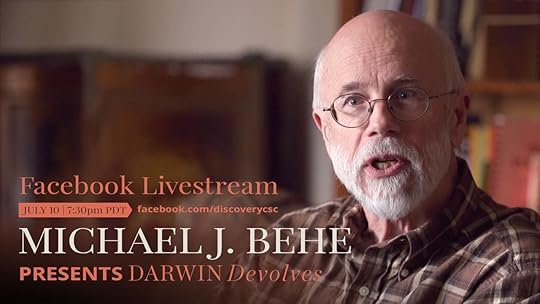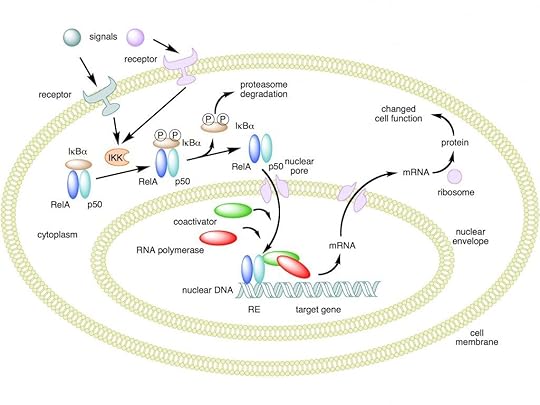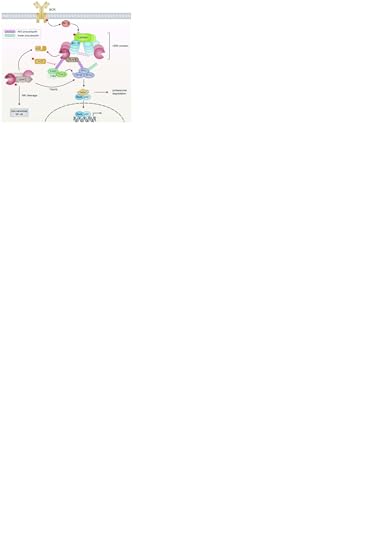Michael J. Behe's Blog, page 456
July 13, 2019
A black hole that just shouldn’t exist
 Black hole concept /© vchalup , Adobe Stock
Black hole concept /© vchalup , Adobe Stock From ScienceDaily:
The conundrum is that the disk shouldn’t be there, based on current astronomical theories. However, the unexpected presence of a disk so close to a black hole offers a unique opportunity to test Albert Einstein’s theories of relativity. General relativity describes gravity as the curvature of space and special relativity describes the relationship between time and space.
“We’ve never seen the effects of both general and special relativity in visible light with this much clarity,” said Marco Chiaberge of the European Space Agency, and the Space Telescope Science Institute and Johns Hopkins University, both in Baltimore, Maryland, a member of the team that conducted the Hubble study.
“This is an intriguing peek at a disk very close to a black hole, so close that the velocities and the intensity of the gravitational pull are affecting how the photons of light look,” added the study’s first author, Stefano Bianchi of Università degli Studi Roma Tre, in Rome, Italy. “We cannot understand the data unless we include the theories of relativity.” …
“The type of disk we see is a scaled-down quasar that we did not expect to exist,” Bianchi said. “It’s the same type of disk we see in objects that are 1,000 or even 100,000 times more luminous. The predictions of current models for gas dynamics in very faint active galaxies clearly failed.” Paper. (open access) – Stefano Bianchi, Robert Antonucci, Alessandro Capetti, Marco Chiaberge, Ari Laor, Loredana Bassani, Francisco J Carrera, Fabio La Franca, Andrea Marinucci, Giorgio Matt, Riccardo Middei, Francesca Panessa. HST unveils a compact mildly relativistic broad-line region in the candidate true type 2 NGC 3147. Monthly Notices of the Royal Astronomical Society: Letters, 2019; 488 (1): L1 DOI: 10.1093/mnrasl/slz080
More.
It’s fun reading about black hole studies where the hole isn’t targeted as the gateway to a multiverse. Just an outcome of the physics of our universe. But still kind of mysterious…
Sometimes, when it comes to getting real information, less is more.
See also: Sabine Hossenfelder: Black holes vs. quantum mechanics: Something has to give
Follow UD News at Twitter!
Copyright © 2019 Uncommon Descent . This Feed is for personal non-commercial use only. If you are not reading this material in your news aggregator, the site you are looking at is guilty of copyright infringement UNLESS EXPLICIT PERMISSION OTHERWISE HAS BEEN GIVEN. Please contact legal@uncommondescent.com so we can take legal action immediately.
Plugin by Taragana
Is human cloning possible? Neurosurgeon and philosopher spar
Neurosurgeon Michael Egnor says it doesn’t happen because it can’t happen:
 Michael Egnor
Michael EgnorThree reasons why humans won’t be cloned: … 1. Biological: Reproductive cloning of non-human animals has become relatively routine and it works quite well. Reproductive cloning of human beings has been an abject failure, despite what are undoubtedly herculean efforts by some (probably many) labs. From a biological standpoint, there appears to be something radically different about cloning non-human animals and cloning humans. …
I am prepared to subject my belief that humans cannot be cloned like Dolly the sheep to the test
Both materialist and immaterialist theories of the mind should be subject to empirical testing—neither should be exempt.
vs.

Jay Wesley Richards
Philosopher Jay Richards says it could happen but wouldn’t have the consequences Dr. Egnor thinks:
Jay Richards: I agree with Mike Egnor that the mind is immaterial but I don’t think human cloning is impossible
“Mike is right that scientists have had a harder time producing human clones than they have had with other organisms. But I don’t see any good reason—whether biological or metaphysical—to doubt that they will eventually succeed. But if and when they do, they will not have copied a person. They will, in effect, have produced a twin of a human being using biological precursors quite similar those that naturally give rise to a human being. And that twin will be less similar to the donor than two identical twins are to each other. After all, identical twins don’t just share DNA. They share the original ovum from their mother as well.”
There are, of course, empirical implications of both the materialist and non-materialist understanding of the human mind. But the success of human cloning won’t weigh on the question one way or the other.
See also: Are lab-grown human brains the Next Big Thing? Neurosurgeon Michael Egnor thinks the hopes for humanly conscious lab-grown brains are faint indeed.
Copyright © 2019 Uncommon Descent . This Feed is for personal non-commercial use only. If you are not reading this material in your news aggregator, the site you are looking at is guilty of copyright infringement UNLESS EXPLICIT PERMISSION OTHERWISE HAS BEEN GIVEN. Please contact legal@uncommondescent.com so we can take legal action immediately.
Plugin by Taragana
July 12, 2019
New Scientist: Our understanding of the cosmos is “seriously wrong”
And new data are making the problem worse:
Something is wrong with the expansion of the universe. Nearby galaxies seem to be moving away from one another too fast, we don’t know why, and every new set of data just seems to make the problem worse.
Leah Crane, “Something is seriously wrong with our understanding of the cosmos” at New Scientist
You have to pay to read the rest. The scene is ripe for the emergence of crackpot cosmologies like the multiverse, the computer sim universe, and why the space aliens are taking so long to land. Is that why we see so many of them?
Theoretical physicist Ethan Siegel says we’ll never know everything:
The total amount of information accessible to us in the Universe is finite, and hence, so is the amount of knowledge we can gain about it. There’s a limit to the amount of energy we can access, the particles we can observe and the measurements we can make. That doesn’t mean we’re done, or that we shouldn’t strive to learn everything we absolutely can. Only we can push the frontiers of knowledge back as far as they can go.
There’s a whole lot left to learn and a whole lot that science has yet to reveal. If we continue to look, many of the present unknowns will likely fall in the near future. But what is knowable is finite, and this implies that there are necessarily some things we may never know. The Universe may yet be infinite, but our knowledge of it never will be.
Ethan Siegel, “This Is Why We Will Never Know Everything About Our Universe” at Forbes
So don’t fret that a better understanding of the universe will leave entertaining crackpots out in the cold. Won’t happen. Can’t.
See also: Tales of an invented god
Copyright © 2019 Uncommon Descent . This Feed is for personal non-commercial use only. If you are not reading this material in your news aggregator, the site you are looking at is guilty of copyright infringement UNLESS EXPLICIT PERMISSION OTHERWISE HAS BEEN GIVEN. Please contact legal@uncommondescent.com so we can take legal action immediately.
Plugin by Taragana
Could “quasiparticles” reveal dark matter?
 3-D impression of dark matter via Hubble
3-D impression of dark matter via HubbleDark matter is thought to make up 80% of the mass of our universe but current physics has no clue what it is:
These dark matter particles are streaming through your room right now. They’re streaming through you. A never-ending rain shower of tiny, invisible dark matter particles. But you simply don’t notice them. They don’t interact with light or with charged particles. You are made of charged particles and you are very friendly with light; you are invisible to dark matter and dark matter is invisible to you. The only way we “see” dark matter is through the gravitational force; gravity notices every form of matter and energy in the universe, dark or not, so at the largest scales, we observe the influence of the combined mass of all these countless particles. But here in your room? Nothing.
Paul Sutter, “These Odd ‘Quasiparticles’ Could Finally Unmask Dark Matter” at Space.com
One group of physicists proposes an experiment to try to trick dark matter into revealing itself, involving a unit of energy called a “magnon”:
In a recent article published in the preprint online journal arXiv, physicists detail a proposed experimental setup that could spot a dark matter particle in the act of changing the spin of electrons (if, in fact, dark matter can do that). In this setup, dark matter can potentially be detected, even if the suspect particle is very light. It can do this by creating so-called magnons in the material.
Paul Sutter, “These Odd ‘Quasiparticles’ Could Finally Unmask Dark Matter” at Space.com
Here’s the paper.
See also: Discover: Even the best dark matter theories are crumbling
Researcher: The search for dark matter has become a “quagmire of confirmation bias” So many research areas in science today are hitting hard barriers that it is reasonable to think that we are missing something.
Physicists devise test to find out if dark matter really exists
Largest particle detector draws a blank on dark matter
What if dark matter just doesn’t stick to the rules?
A proposed dark matter solution makes gravity an illusion
and
Proposed dark matter solution: “Gravity is not a fundamental governance of our universe, but a reaction to the makeup of a given environment.”
Copyright © 2019 Uncommon Descent . This Feed is for personal non-commercial use only. If you are not reading this material in your news aggregator, the site you are looking at is guilty of copyright infringement UNLESS EXPLICIT PERMISSION OTHERWISE HAS BEEN GIVEN. Please contact legal@uncommondescent.com so we can take legal action immediately.
Plugin by Taragana
Researchers: Humans are much more sensitive to pitch than monkeys are

music/© sharaku1216, Adobe Stock
From ScienceDaily:
In the eternal search for understanding what makes us human, scientists found that our brains are more sensitive to pitch, the harmonic sounds we hear when listening to music, than our evolutionary relative the macaque monkey. The study, funded in part by the National Institutes of Health, highlights the promise of Sound Health, a joint project between the NIH and the John F. Kennedy Center for the Performing Arts that aims to understand the role of music in health …
At first glance, the scans looked similar and confirmed previous studies. Maps of the auditory cortex of human and monkey brains had similar hot spots of activity regardless of whether the sounds contained tones.
However, when the researchers looked more closely at the data, they found evidence suggesting the human brain was highly sensitive to tones. The human auditory cortex was much more responsive than the monkey cortex when they looked at the relative activity between tones and equivalent noisy sounds. …
“We found that human and monkey brains had very similar responses to sounds in any given frequency range. It’s when we added tonal structure to the sounds that some of these same regions of the human brain became more responsive,” said Dr. Conway. “These results suggest the macaque monkey may experience music and other sounds differently. In contrast, the macaque’s experience of the visual world is probably very similar to our own. It makes one wonder what kind of sounds our evolutionary ancestors experienced.”
Further experiments supported these results. Slightly raising the volume of the tonal sounds had little effect on the tone sensitivity observed in the brains of two monkeys.
Finally, the researchers saw similar results when they used sounds that contained more natural harmonies for monkeys by playing recordings of macaque calls. Brain scans showed that the human auditory cortex was much more responsive than the monkey cortex when they compared relative activity between the calls and toneless, noisy versions of the calls.
“This finding suggests that speech and music may have fundamentally changed the way our brain processes pitch,” said Dr. Conway. “It may also help explain why it has been so hard for scientists to train monkeys to perform auditory tasks that humans find relatively effortless.”
“We found that a certain region of our brains has a stronger preference for sounds with pitch than macaque monkey brains,” said Bevil Conway, Ph.D., investigator in the NIH’s Intramural Research Program and a senior author of the study published in Nature Neuroscience. “The results raise the possibility that these sounds, which are embedded in speech and music, may have shaped the basic organization of the human brain.” Paper. paywall – Sam V. Norman-Haignere, Nancy Kanwisher, Josh H. McDermott, Bevil R. Conway. Divergence in the functional organization of human and macaque auditory cortex revealed by fMRI responses to harmonic tones. Nature Neuroscience, 2019; 22 (7): 1057 DOI: 10.1038/s41593-019-0410-7
More.
A macaque wouldn’t really need to know pitch anyway.
See also: Birds “Behave Like Human Musicians”? This Is Getting Ridiculous.
and
Can randomness produce music?
Follow UD News at Twitter!
Copyright © 2019 Uncommon Descent . This Feed is for personal non-commercial use only. If you are not reading this material in your news aggregator, the site you are looking at is guilty of copyright infringement UNLESS EXPLICIT PERMISSION OTHERWISE HAS BEEN GIVEN. Please contact legal@uncommondescent.com so we can take legal action immediately.
Plugin by Taragana
July 11, 2019
Yet another new type of intercellular communication discovered
From ScienceDaily:
Without touching and without electrical or chemical signals, individual Spirostomum can coordinate their ultrafast contractions so closely that groups of them appear to shrink simultaneously — a reaction to predators that makes them release paralyzing toxins in sync.
“There are many different ways of communication in biology but this is really a new kind of signaling between cells that we’re trying to understand,” said Arnold Mathijssen, a postdoctoral scholar in the Prakash lab and lead author of the paper. “It’s possible this is more universal than we’ve described so far and is a way many different kinds of organisms communicate.” …
“The first cell contracts and generates a flow, which triggers the second and that one triggers the third. So, you get this propagating trigger wave that passes through the whole colony,” described Mathijssen. “These are big, long-range vortex flows and the velocities of the communication rise up to meters per second — even though each cell is only 1 to 4 millimeters long.” Paper. paywall – Arnold J. T. M. Mathijssen, Joshua Culver, M. Saad Bhamla, Manu Prakash. Collective intercellular communication through ultra-fast hydrodynamic trigger waves. Nature, 2019; DOI: 10.1038/s41586-019-1387-9 More.
Amazing how often so many life forms have just gotten lucky and tumbled into exactly what they needed via pure randomness.
Before you go: DNA uses “climbers’ ropes method” to keep tangles at bay It all just swished into place among unthinking cells billions of yours ago. Otherwise, we wouldn’t be here. Go tell it on the mountain.
DNA as a master of resource recycling
The amazing energy efficiency of cells: A science writer compares the cell to human inventions and finds that it is indeed amazingly energy-efficient.
In addition to DNA, our cells have an instruction language written in sugar Of course, it all just tumbled into existence and “natural selection” somehow organized everything. As if.
Cells find optimal solutions. Not just good ones.
Researchers build “public library” to help understand photosynthesis
Wait. “The part of the plant responsible for photosynthesis is like a complex machine made up of many parts, … ” And machines just happen all by themselves, right? There is no information load to account for; it just evolved by natural selection acting on random mutation the way your Android did!
In Nature: Cells have “secret conversations” We say this a lot: That’s a lot of information to have simply come into being by natural selection acting on random mutation (Darwinism). It’s getting not only ridiculous but obviously ridiculous.
Follow UD News at Twitter!
Researchers: Helpful gut microbes send messages to their hosts If the strategy is clearly identified, they should look for non-helpful microbes that have found a way to copy it (horizontal gene transfer?)
Cells and proteins use sugars to talk to one another Cells are like Neanderthal man. They get smarter every time we run into them. And just think, it all just tumbled into existence by natural selection acting on random mutations (Darwinism) too…
Researchers: First animal cell was not simple; it could “transdifferentiate” From the paper: “… these analyses offer no support for the homology of sponge choanocytes and choanoflagellates, nor for the view that the first multicellular animals were simple balls of cells with limited capacity to differentiate.”
“Interspecies communication” strategy between gut bacteria and mammalian hosts’ genes described
Researchers: Cells Have A Repair Crew That Fixes Local Leaks
Researchers: How The Immune System “Thinks”
Follow UD News at Twitter!
Researcher: Mathematics Sheds Light On “Unfathomably Complex” Cellular Thinking
How do cells in the body know where they are supposed to be?
Researchers A Kill Cancer Code Is Embedded in Every Cell
Copyright © 2019 Uncommon Descent . This Feed is for personal non-commercial use only. If you are not reading this material in your news aggregator, the site you are looking at is guilty of copyright infringement UNLESS EXPLICIT PERMISSION OTHERWISE HAS BEEN GIVEN. Please contact legal@uncommondescent.com so we can take legal action immediately.
Plugin by Taragana
Computer sim universe: An escape from the facts of fine-tuning?
Walter Bradley Center fellows weigh in:
The idea that we are a simulation by space aliens is a staple of science fiction, of course (think The Matrix, 1999). But some scientists take this simulation hypothesis seriously.
Serious discussion started with a paper by philosopher Nick Bostrom in 2003, “Are you living in a computer simulation?” in which he suggests, “One thing that later generations might do with their super-powerful computers is run detailed simulations of their forebears or of people like their forebears.”…
Jonathan Bartlett offers,
The simulation hypothesis is interesting but it fails precisely because it is too loosely stated, and equivocates more than it clarifies.
The primary “proof” for the simulation hypothesis is that, let’s say that we could simulate a universe. If we do, there are now two universes, ours and the simulated one. In the simulated universe, if it succeeds, there will eventually be organisms that can also discover how to simulate a universe. Now we have three universes, and two of them are simulated. So, if you wake up in any universe, there is now a higher probability of a particular universe being simulated than the universe being real…”
“How do we know that our universe is not a sim world?” at Mind Matters News
It gets crazier. You will reach for sanity and not find it… 
Jeff Epstein’s cultural dumpster fire spreads to ID vs. evo controversies
American billionaire Epstein, as most likely know, was arrested on child sex charges. He hobnobbed with everyone. Names you may know:
As a philanthropist, Epstein aligned himself with many prominent scientists and leading thinkers, including Lawrence Krauss, a prominent theoretical physicist, bestselling author, and so-called “celebrity scientist” who directed a program on the origins of life that Epstein funded. Krauss gave a glowing quote in defense of his benefactor to the Daily Beast following Epstein’s brief incarceration. “If anything, the unfortunate period he suffered has caused him to really think about what he wants to do with his money and his time, and support knowledge,” Krauss told the Daily Beast in 2011. “Jeffrey has surrounded himself with beautiful women and young women but they’re not as young as the ones that were claimed. As a scientist I always judge things on empirical evidence and he always has women ages 19 to 23 around him, but I’ve never seen anything else, so as a scientist, my presumption is that whatever the problems were I would believe him over other people.” Coincidentally, Krauss himself was put on paid leave by Arizona State University after facing his own sexual misconduct allegations in 2018; an ASU investigation found sufficient evidence that Krauss had violated its sexual harassment policies. Though he denied the claims, he retired shortly thereafter.
E. J. Dickson, “Accused Sex Trafficker Jeffrey Epstein’s Political Connections: A Guide” at Rolling Stone
Some groups that readers might recognize received funds from Epstein and are now squirming:
The Santa Fe Institute says the last donation it received from Epstein was in 2010… Jenna Marshall, spokesperson for the institute, told NBC News in an email that Epstein’s behavior was “appalling” and that SFI had not accepted any money from him since 2010. “Following news of Mr. Epstein’s actions,” said Marshall, “the SFI leadership team held a meeting and unanimously decided the Institute would not accept any donations from Mr. Epstein.”
NautilusThink, which publishes the science magazine Nautilus, received a $25,000 donation from Epstein’s foundation in 2017, according to federal filings. John Steele, publisher and editorial director of Nautilus, said, “We have not returned it. But we’re starting to think about it now.”
Laura Strickler and Shelby Hanssen, “Jeffrey Epstein may have exaggerated his charity donations” at NBC News
Just because people are in the news doesn’t mean they did anything. It rather shows how a bad actor can change the news picture.
See also: Alleged sex trafficker Jeffrey Epstein pledged $30 million for Harvard evolution program. Some of these areas would seem to be science issues and others only questionably so. It is much easier to get general, evidence-based agreement on what constitutes cancer and its remedies, for example, than on what constitutes selfishness and its remedies.
Follow UD News at Twitter!
Copyright © 2019 Uncommon Descent . This Feed is for personal non-commercial use only. If you are not reading this material in your news aggregator, the site you are looking at is guilty of copyright infringement UNLESS EXPLICIT PERMISSION OTHERWISE HAS BEEN GIVEN. Please contact legal@uncommondescent.com so we can take legal action immediately.
Plugin by Taragana
July 10, 2019
Mike Behe’s book party for Darwin Devolves live-streamed from Seattle tonight

While Stephen Colbert has called Michael J. Behe the “Father of Intelligent Design,” Behe’s arguments have been called “close to heretical” by the New York Times Book Review, and Richard Dawkins has publicly taken him to task for his “maverick” views. Wherever he goes, Behe makes waves, but has remained singularly focused on doing rigorous scientific analysis that points to controversial but incredible results that other scientists won’t touch.
“Seattle Book Party” at Evolution News and Science Today:
Live stream here, 7:00 pm Pacific time.

Darwin Devolves at Amazon:
Amazon Best Sellers Rank: #40,870 in Books (See Top 100 in Books)
#8 in Developmental Biology (Books)#56 in Science & Religion#14 in Creationism
Follow UD News at Twitter!
Copyright © 2019 Uncommon Descent . This Feed is for personal non-commercial use only. If you are not reading this material in your news aggregator, the site you are looking at is guilty of copyright infringement UNLESS EXPLICIT PERMISSION OTHERWISE HAS BEEN GIVEN. Please contact legal@uncommondescent.com so we can take legal action immediately.
Plugin by Taragana
Controlling the waves of dynamic, far from equilibrium states: the NF-kB system of transcription regulation.

I have recently commented on another thread:
Researcher asks, Is the cell REALLY a machine?
about a paper that (very correctly) describes cells as dynamic,
far from equilibrium systems, rather than as “traditional” machines.
That is true. But, of course, the cell implements the same functions as complex machines do, and much more. My simple point is that, to do that, you need much greater functional complexity than you need to realize a conventional machine.
IOWs, dynamic, far from equilibrium systems that can be as successful as a conventional machine, or more, must certainly be incredibly complex and amazing systems, systems that defy everything else that we already know and that we can conceive. They must not only implement their functional purposes, but they must do that by “harnessing” the constantly changing waves of change, of random noise, of improbability. I have commented on those ideas in the mentioned thread, at posts #5 and #8, and I have quoted at posts #11 and #12 a couple of interesting and pertinent papers, introducing the important concept of robustness: the ability to achieve reliable functional results in spite of random noise and disturbing variation.
In this OP, I would like to present in some detail a very interesting system that shows very well what we can understand, at present, of that kind of amazing systems.
The system I will discuss here is an old friend: it is the NF-kB system of transcription factors (nuclear factor kappa-light-chain-enhancer of activated B cells). We are speaking, therefore, of transcription regulation, a very complex topic that I have already discussed in some depth here:
Transcription regulation: a miracle of engineering
I will remind here briefly that transcription regulation is the very complex process that allows cells to be completely different using the same genomic information: IOWs, each type of cell “reads” differently the genes in the common genome, and that allows the different types of cell differentiation and the different cell responses in the same cell type.
Transcription regulation relies on many different levels of control, that are summarized in the above quoted OP, but a key role is certainly played by Transcription Factors (TFs), proteins that bind DNA and act as activators or inhibitors of transcription at specific sites.
TFs are a fascinating class of proteins. There are a lot of them (1600 – 2000 in humans, almost 10% of all proteins), and they are usually medium sized proteins, about 500 AA long, containing at least one highly conserved domain, the DNA binding domain (DBD), and other, often less understood, functional components.
I quote again here a recent review about human TFs:
The Human Transcription Factors
The NK-kB system is a system of TFs. I have discussed it in some detail in the discussion following the Ubiquitin thread, but I will describe it in a more systematic way here.
In general, I will refer a lot to
this very recent paper about it:
Considering Abundance, Affinity, and Binding Site Availability in the NF-kB Target Selection Puzzle
The NF-kB system relies essentially on 5 different TFs (see Fig. 1 A in the paper):
RelA (551 AAs)RelB (579 AAs)c-Rel (619 AAs)p105/p50
(968 AAs)p100/p52 (900 AAs)
Those 5 TFs work forming dimers,
homodimers or heterodimers, for a total of 15 possible compbinations, all of
which have been found to work in the cell, even if some of them are much more
common.
Then there are at least 4
inhibitor proteins, collectively called IkBs.
The mechanism is apparently simple enough. The dimers are inhibited by IkBs and therefore they remain in the cytoplasm in inactive form.
When an appropriate signal arrives to the cell and is received by a membrane receptor, the inhibitor (the IkB molecule) is phosphorylated and then ubiquinated and detached from the complex. This is done by a protein complex called IKK. The free dimer can then migrate to the nucleus and localize there, where it can act as a TF, binding DNA.
This is the canonical activation pathway, summarized in Fig. 1. There is also a non canonical activation pathway, that we will not discuss for the moment.

Mechanism of NF-κB action. In this figure, the NF-κB heterodimer consisting of Rel and p50 proteins is used as an example. While in an inactivated state, NF-κB is located in the cytosol complexed with the inhibitory protein IκBα. Through the intermediacy of integral membrane receptors, a variety of extracellular signals can activate the enzyme IκB kinase (IKK). IKK, in turn, phosphorylates the IκBα protein, which results in ubiquitination, dissociation of IκBα from NF-κB, and eventual degradation of IκBα by the proteasome. The activated NF-κB is then translocated into the nucleus where it binds to specific sequences of DNA called response elements (RE). The DNA/NF-κB complex then recruits other proteins such as coactivators and RNA polymerase, which transcribe downstream DNA into mRNA. In turn, mRNA is translated into protein, resulting in a change of cell function.
Attribution: Boghog2 at English Wikipedia [Public domain]
Now, the purpose of this OP is to show, in greater detail, how this mechanism, apparently moderately simple, is indeed extremely complex and dynamic. Let’s see.
The stimuli.
First of all, we must understand
what are the stimuli that, arriving to the cell membrane, are capable to
activate the NF-kB system. IOWs, what are the signals that work as inputs.
The main concept is: the NF-kB
system is a central pathway activated by many stimuli:
InflammationStressFree
radicalsInfectionsRadiationImmune
stimulation
IOWs, a wide variety of aggressive
stimuli can activate the system
The extracellular signal arrives to the cell usually through specific cytokines, for example TNF, IL1, or through pathogen associated molecules, like bacterial lipopolysaccharides (LPS). Of course there are different and specific membrane receptors, in particular IL-1R (for IL1) , TNF-R (for TNF), and many TLRs (Toll like receptors, for pathogen associated structures). A special kind of activation is implemented, in B and T lymphocytes, by the immune activation of the specific receptors for antigen epitopes (B cell receptor, BCR, and T cell receptor, TCR).
The process through which the activated receptor can activate the NF-kB dimer is rather complex: it involves, in the canonical pathway, a macromolecular complex called IKK (IkB kinase) complex, comprising two catalytic kinase subunits (IKKa and IKKb) and a regulatory protein (IKKg/NEMO), and involving in multiple and complex ways the ubiquitin system. The non canonical pathway is a variation of that. Finally, a specific protein complex (CBM complex or CBM signalosome) mediates the transmission from the immune BCR or TCR to the canonical pathway. See Fig. 2:
 From: NF-κB Activation in Lymphoid Malignancies: Genetics, Signaling, and Targeted Therapy – Scientific Figure on ResearchGate. Available from: https://www.researchgate.net/figure/I... [accessed 10 Jul, 2019]
From: NF-κB Activation in Lymphoid Malignancies: Genetics, Signaling, and Targeted Therapy – Scientific Figure on ResearchGate. Available from: https://www.researchgate.net/figure/I... [accessed 10 Jul, 2019] Figure 3 – NF-κB Activation in Lymphoid Malignancies: Genetics, Signaling, and Targeted Therapy
available via license: Creative Commons Attribution 4.0 International
I will not go into further details about this part, but those interested can have a look at this very good paper:
TLR-4, IL-1R and TNF-R signaling to NF-kB: variations on a common theme
In particular, Figg. 1, 2, 3.
In the end, as a result of the activation process, the IkB inhibitor is degraded by the ubiquitin system, and the NK-kB dimer is free to migrate to the nucleus.
An important concept is that this is a “rapid-acting” response system, because the dimers are already present, in inactive form, in the cytoplasm, and must not be synthesized de novo: so the system is ready to respond to the activating signal.
The response.
But what is the cellular
response?
Again, there are multiple and
complex possible responses.
Essentially, this system is a
major regulator of innate and adaptive immune responses. As such, it has a
central role in the regulation of inflammation, in immunity, in autoimmune
processes, and in cancer.
Moreover, the NF-kB system is rather ubiquitous, and is
present and active in many different cell types. And, as we have seen, it can
be activated by different stimuli, in different ways.
So, the important point is that the response to activation must be (at least):
Lineage-specificStimulus-specific
IOWs, different cells must be able to respond differently,
and each cell type must respond differently to different stimuli. That gives a
wide range of possible gene expression patterns at the transcription level.
The following paper is a good review of the topic:
Selectivity of the NF-κB Response
For example, IL2 is induced by NF-kB activayion in T cells,
but not in B cells (lineage specific response). Moreover, specific cell types
can undergo specific, and often different, cell destinies after NF-kB activation:
for example, NK-kB is strongly involved in the control and regulation of T and
B cell development.
From:
30 years of NF-κB: a blossoming of relevance to human pathobiology
“B and T
lymphocytes induce NF-κB in adaptive immune responses through the
CARD11:Bcl10:MALT1 (CBM) complex (Hayden and Ghosh, 2008). Newly expressed genes promote lymphocyte proliferation and
specific immune functions including antibody production by B cells and the
generation of cytokines and other anti-pathogen responses by T cells.”
And, in the same cell type, certain promoters regulated by
NF-kB require additional signaling (for example, in human dendritic cells promoters for Il6, Il12b, and MCP-1 require additional
p38 histone phosphorylation to be activated), while others can be activated
directly (stimulus-specific response).
So, to sum up:
A variety of stimuli can activate the system in different waysThe system itself has its complexity (different dimers)The response can be widely different, according to the cell type where it happens, and to the type of stimuli that have activated the system, and probably according to other complex variables.The possible responses include a wide range of regulations of inflammation, of the immune system, of cell specifications or modifications, and so on.
How does it work?
So, what do we
know about the working of such a system?
I will ignore, for the moment, the many complexities of the activation pathways, both canonical and non canonical, the role of cyotkines and receptors and IKK complexes, the many facets of NEMO and of the involvement of the ubiquitin system.
For simplicity, we will start with the activated system: the IkB inhibitor has been released from the inactive complex in the cytoplasm, and some form of NF-kB dimer is ready to migrate to the nucleus.
Let’s remember
that the purpose of this OP is to show that the system works as a
dynamic, far from equilibrium system, rather than as a “traditional” machine.
And that such a way to work is an even more amazing example of design and
functional complexity.
To do that; I will rely mainly on the recent paper quoted at
the beginning:
Considering Abundance, Affinity, and Binding Site Availability in the NF-kB Target Selection Puzzle
The paper is essentially about the NF-kB Target Selection Puzzle. IOWs, it tries to analyze what we know about the specificity of the response. How are specific patterns of transcription achieved after the activation of the system? What mechanisms allow the selection of the right genes to be transcribed (the targets) to implement the specific patterns according to cell type, context, and type of stimuli?
A “traditional” view of the system as a machine would try to
establish rather fixed connections. For example, some type of dimer is
connected to specific stimuli, and evokes specific gene patterns. Or some other
components modulate the effect of NK-kB, generate diversification and
specificity of the response.
Well, those ideas are not completely wrong. In a sense, the
system does work also that way. Dimer specificity has a role. Other components
have a role. In a sense, but only in a sense, the system works as though it
were a traditional machine, and uses some of the mechanisms that we find in the
concept of a traditional biological machine.
But that is only a tiny part of the real thing.
The real thing is that the system really works as a dynamic, far from equilibrium system, harnessing huge random/stochastic components to achieve robustness and complexity and flexibility of behavior in spite of all those non finalistic parts.
Let’s see how that happens, at least for the limited
understanding we have of it. It is important to consider that this is a system
that has been studied a lot, for decades, because of its central role in so
many physiological and pathological contexts, and so we know many things. But
still, our understanding is very limited, as you will see.
So, let’s go back to the paper. I will try to summarize as
simply as possible the main concepts. Anyone who is really interested can refer
to the paper itself.
Essentially, the paper analyzes three important and
different aspects that contribute to the selection of targets at the genomic
level by our TFs (IOWs, our NF-kB dimers, ready to migrate to the nucleus. As
the title itself summarizes, they are:
AbundanceAffinityBinding site availability
1. Abundance
Abundance is referred here to two different variables:
abundance of NF-kB Binding Sites in the genome and abundance of Nucleus-Localized
NF-kB Dimers. Let’s consider them separately.
1a) Abundance of NF-kB Binding Sites in the genome:
It is well known that TFs bind specific sites in the genome.
For NF-kB TFs, the following consensus kB site pattern has been found:
5′-GGGRNWYYCC-3′
where R, W, Y, and N, respectively denote purine, adenine or
thymine, pyrimidine, and any nucleotide.
That simply means that any sequence corresponding to that
pattern in the genome can, in principle, bind NF-kB dimers.
So the problem is: how many such sequences do exist in the
human genome?
Well, a study based on RelA has evaluated about 10^4 consensus sequences in the whole genome, but as NF-kB dimers seem to bind even incomplete consensus sites, the total number of potential binding sites could be nearer to 10^6
1b) Abundance of Nucleus-Localized NF-kB Dimers:
An estimate of the abundance of dimers in the nucleus after activation of the system is that about 1.5 × 10^5 molecules can be found, but again that is derived from studies about RelA only. Moreover, the number of molecules and type of dimer can probably vary much according to cell type.
So, the crucial variable, that is the ratio between binding sites and available dimers, and which could help undertsand the rate of sites saturation in the nucleus, remains rather undecided, and it seems very likely that it can vary a lot in different circumstances.
But there is another very interesting aspect about the concentration of dimers in the nucleus. According to some studies, NF-kB seems to generate oscillations of its nuclear content in some cell types, and those oscillation can be a way to generate specific transcription patterns:
NF-kB oscillations translate into functionally related patterns of gene expression
For example, this very recent paper :
NF-κB Signaling in Macrophages: Dynamics, Crosstalk, and Signal Integration
shows at Fig. 3 the occupancy curve of binding sites at nuclear level after NF-kB activation in two different cell types.
In fibroblasts, the curve is a periodic oscillation, with a frequency that varies according to various factors, and translates into different transcription scenarios accordingly:
Gene expression dynamics scale with the period (g1) and amplitude (g2) of these oscillations, which are influenced by variables such as signal strength, duration, and receptor identity.
In macrophages, instead, the curve is rather:
a single, strong nuclear translocation event which persists for as long as the stimulus remains and tends to remain above baseline for an extended period of time.
In this case, the type of transcription will be probably regulated by the are under the curve, ratehr than by the period and amplitude of the oscialltions, as happened in fibroblasts.
Interestingly, while in previous studies it seemed that the concentration of nuclear dimers could be sufficient to saturate most or all binding sites, that has been found not to be the case in more recent studies. Again from the paper about abundance:
in fact, this lack of saturation of the system is necessary to generate stimulus- and cell-type specific gene expression profiles
Moreover, the
binding itself seems to be rather short-lived:
Interestingly, it is now thought that most functional NF-kB interactions with chromatin—interactions that lead to a change in transcription—are fleeting… a subsequent study using FRAP in live cells expressing RelA-GFP showed that most RelA-DNA interactions are actually quite dynamic, with half-lives of a few seconds… Indeed, a recent study used single-molecule tracking of individual Halo-tagged RelA molecules in live cells to show that the majority (∼96%) of RelA undergoes short-lived interactions lasting on average ∼0.5 s, while just ∼4% of RelA molecules form more stable complexes with a lifetime of ∼4 s.
2. Affinity
Affinity of dimers for DNA sequences is not a clear cut matter. From the paper:
Biochemical DNA binding studies of a wide variety of 9–12 base-pair sequences have revealed that different NF-kB dimers bind far more sequences than previously thought, with different dimer species exhibiting specific but overlapping affinities for consensus and non-consensus kB site sequences.
IOWs, we have
different dimers (15 different types) binding with varying affinity different
DNA sequences (starting from the classical consensus sequence, but including
also incomplete sequences). Remember that those sequences are rather short (the
consensus sequence is 10 nucleotides long), and that there are thousands of
such sequences in the genome.
Moreover,
different bindings can affect transcription differently. Again, from the paper:
How might different consensus kB sites modulate the activity of the NF-kB dimers? Structure-function studies have shown that binding to different consensus kB sites can alter the conformation of the bound NF-kB dimers, thus dictating dimer function When an NF-kB dimer interacts with a DNA sequence, side chains of the amino acids located in the DNA-binding domains of dimers contact the bases exposed in the groove of the DNA. For different consensus kB site sequences different bases are exposed in this groove, and NF-kB seems to alter its conformation to maximize interactions with the DNA and maintain high binding affinity. Changes in conformation may in turn impact NF-kB binding to co-regulators of transcription, whether these are activating or inhibitory, to specify the strength and dynamics of the transcriptional response. These findings again highlight how the huge array of kB binding site sequences must play a key role in modulating the transcription of target genes.
Quite a complex scenario,
I would say!
But there is
more:
Finally, as an additional layer of dimer and sequence-specific regulation, each of the subunits can be phosphorylated at multiple sites with, depending on the site, effects on nearly every step of NF-kB activation.
IOWs, the 15
dimers we have mentioned can be phosphorylated in many different ways, and that
changes their binding affinities and their effects on transcription.
This section of
the paper ends with a very interesting statement:
Overall, when considering the various ways in which NF-kB dimer abundances and their affinity for DNA can be modulated, it becomes clear that with these multiple cascading effects, small differences in consensus kB site sequences and small a priori differences in interaction affinities can ultimately have a large impact on the transcriptional response to NF-kB pathway activation.
Emphasis mine.
This is interesting, because in some way it seems to suggest that the whole system acts like a chaotic system, at least at some basic level. IOWs, small initial differences, maybe even random noise, can potentially affect deeply the general working of the whole systems.
Unless, of course, there is some higher, powerful level of control.
3. Availability of high affinity kB binding sequences
We have seen that there is a great abundance and variety of binding sequences for NF-kB dimers in the human genome. But, of course, those sequences are not necessarily available. Different cell types will have a different scenario of binding sites availability.
Why?
Because, as we know, the genome and chromatin are a very dynamic system, that can exist in many different states, continuosly changing in different cell types and, in the same cell type, in different conditions..
We know rather well the many levels of control that affect DNA and chromatin state. In brief, they are essentially:
DNA methylationHistone modifications (methylation, acetylation, etc) Chromatin modificationsHigher levels of organization, including nuclear localization and TADs (Topologically Associating Domains)
For example, from
the paper:
The promoter regions of early response genes have abundant histone acetylation or trimethylation prior to stimulation [e.g., H3K27ac, (67) and H4K20me3, (66)], a chromatin state “poised” for immediate activation… In contrast, promoters of late genes often have hypo-acetylated histones, requiring conformational changes to the chromatin to become accessible. They are therefore unable to recruit NF-kB for up to several hours after stimulation (68), due to the slow process of chromatin remodeling.
We must remember that each wave of NK-kB activation translates into the modified transcription of a lot of different genes at the genome level. It is therefore extremely important to consider what genes are available (IOWs, their promoters can be reached by the NF-kB signal) in each cell type and cell state.
The paper
concludes:
Taken together, chromatin state and chromatin organization strongly influence the selection of DNA binding sites by NF-kB dimers and, most likely, the selection of the target genes that are regulated by these protein-DNA interaction events. Analyses that consider binding events in the context of three-dimensional nuclear organization and chromatin composition will be required to generate a more accurate view of the ways in which NF-kBDNA binding affects gene transcription.
This is the main scenario. But there are other components, that I have not considered in detail for the sake of brevity, for example competition between NF-kB dimers and the complex role and intervention of other co-regulators of transcription.
Does the system
work?
But does the system work?
Of course it does. It is a central regulator, as we have said, of many extremely important biological processes, above all immunity. This is the system that decides how immune cells, T and B lymphocytes, have to behave, in terms of cell destiny and cell state. It is of huge relevance in all inflammatory responses, and in our defense against infections. It works, it works very well.
And what happens if it does not work properly?
Of course, like
all very complex systems, errors can happen. Those interested can have a look
at this recent paper:
30 years of NF-κB: a blossoming of relevance to human pathobiology
First of all, many serious genetic diseases have been linked to mutations in genes involved in the system. You can find a list in Table 1 of the above paper. Among them, for example, some forms of SCID, Severe combined immunodeficiency, one of the most severe genetic diseases of the immune system.
But, of course, a dysfunction of the NF-kB system has a very important role also in autoimmune diseases and in cancer.
Conclusions.
So, let’s try to sum up what we have seen here in the light of the original statement about biological systems that “are not machines”.
The NF-kB system is a perfect example. Even if we still understand very little of how it works, it is rather obvious that it is not a traditional machine.
A traditional machine would work differently. The signal would be transmitted from the membrane to the nucleus in the simplest possible way, without ambiguities and diversions. The Transcription Factor, once activated, would bind, at the level of the genome, very specific sites, each of them corresponding to a definite cascade of specific genes. The result would be clear cut, almost mechanical. Like a watch.

But that’s not
the way things happen. There are myriads of variations, of ambiguities, of stochastic
components.
The signal arrives to the membrane in multiple ways, very different one from the other: IL1, IL17, TNF, bacterial LPS, and immune activation of the B cell receptor (BCR) or the T cell receptor (TCR) are all possible signals.
The signal is translated to the NF-kB proteins in very different ways: canonical or non canonical activation, involving complex protein structures such as:
The CBM signalosome, intermediate between immune activation of BCR or TCR and canonical activation of the NF-kB. This complex is made of at least three proteins, CARD11, Bcl10 and MALT1.
The IKK complex in canonical activation: this is made of three proteins, IKK alpha, IKK beta, and NEMO. Its purpose is to phosphorylate the IkB, the inhibitor of the dimers, so that it can be ubiquinated and released from the dimer. Then the dimer can relocate to the nucleus.
Non canonical pathway: it involves the following phosphorylation cascade: NIK -> IKK alpha dimer -> Relb – p100 dimer -> Relb – p50 dimer (the final TF). It operates during the development of lymphoid organs and is responsible for the generation of B and T lymphocytes.
Different kinds of activated dimers relocate to the nucleus.
Different dimers, in varying abundance, interact with many different binding sites: complete or incomplete consensus sites, and probably others. The interaction is usually brief, and it can generate an oscillating pattern, or a more stable pattern
Completely different sets of genes are transcribed in different cell types and in different contexts, because of the interaction of NF-kB TFs with their promoters.
Many other factors and systems contribute to the final result.
The chromatin state of the cell at the moment of the NF-kB activation is essential to determine the accessibility of different binding sites, and therefore the final transcription pattern.
All these events and interactions are quick, unstable, far from equilibrium. A lot of possible random noise is involved.
In spite of that amazing complexity and potential stochastic nature of the system, reliable transcripion regulation and results are obtained in most cases. Those results are essential to immune cell differentiation, immune response, both innate and adaptive, inflammation, apoptosis, and many other crucial cellular processes.
So, let’s go back
to our initial question.
Is this the working of a machine?
Of course it is!
Because the results are purposeful, reasonably robust and reliable, and govern
a lot of complex processes with remarkable elegance and efficiency.
But certainly, it is not a traditional machine. It is a lot more complex. It is a lot more beautiful and flexible.
It works with biological realities and not with transistors and switches. And biological realities are, by definition, far from equilibrium states, improbable forms of order that must continuously recreate themselves, fighting against the thermodynamic disorder and the intrinsic random noise that should apparently dominate any such scenario.
It is more similar to a set of extremely clever surfers who succeed in performing elegant and functional figures and motions in spite of the huge contrasting waves.

It is, from all
points of view, amazing.
Now, Paley was
absolutely right. No traditional machine, like a watch, could ever originate
without design.
And if that is
true of a watch, with its rather simple and fixed mechanisms, how much truer it
must be for a system like NF-kB? Or, for that, like any cellular complex
system?
Do you still have any doubts?
Copyright © 2019 Uncommon Descent . This Feed is for personal non-commercial use only. If you are not reading this material in your news aggregator, the site you are looking at is guilty of copyright infringement UNLESS EXPLICIT PERMISSION OTHERWISE HAS BEEN GIVEN. Please contact legal@uncommondescent.com so we can take legal action immediately.
Plugin by Taragana
Michael J. Behe's Blog
- Michael J. Behe's profile
- 219 followers



